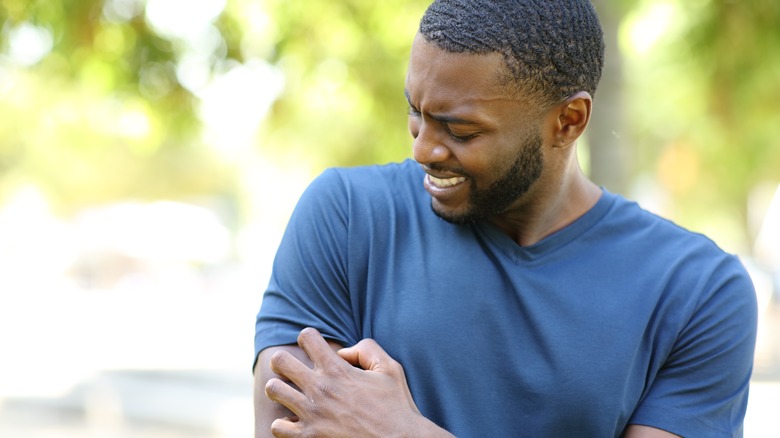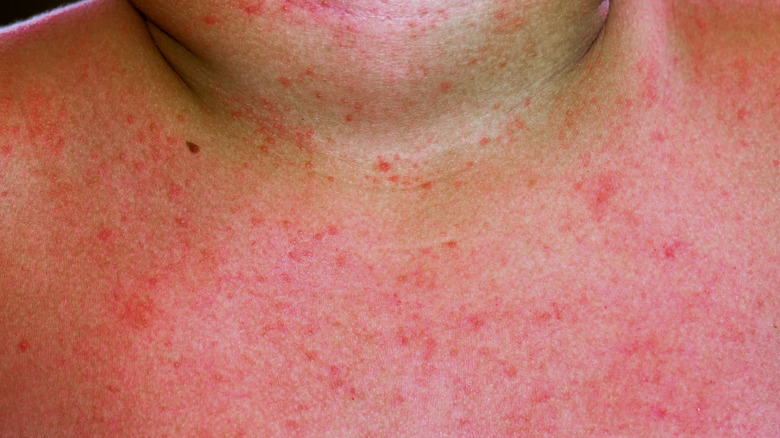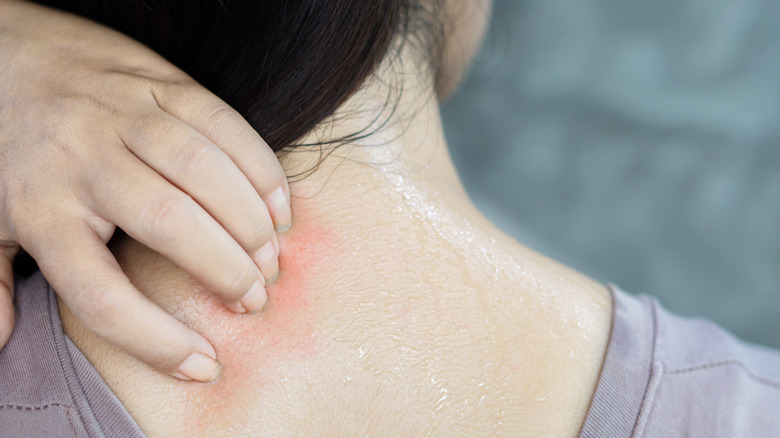What You Should Do If You Have A Heat Rash
We may receive a commission on purchases made from links.
From balmy weather to days at the beach, there are infinite reasons to love summer. Unfortunately, summer is also the prime season for the itchy condition known as heat rash. Sometimes called "prickly heat," heat rash often consists of small bumps or blisters that appear on the skin. Talking to Shape, board-certified dermatologist Hadley King, M.D., explains that the condition, for which the medical term is miliaria, can come in several forms. Mild heat rash, called miliaria crystallina, presents with small clear blisters, while the more severe miliaria rubra appears with angry red skin and deep, itchy red bumps and blisters.
Heat rash occurs when sweat becomes trapped in the skin's pores. This can happen when restrictive clothing prevents sweat from evaporating naturally or when there are other blockages present on the skin, such as heavy sunscreens that can clog pores. Healthline explains that anyone can get heat rash, but those most likely to be afflicted tend to live in hot, humid environments. Heat rash typically appears under the arms, around skin folds on the neck, and near the groin, though it can show up anywhere on your body where sweat gets trapped.
Though not usually dangerous, heat rash is often itchy, uncomfortable, and irritating enough to ruin your summer vacation. The good news is that mild forms of the condition can be treated at home with natural remedies or over-the-counter products. There are also a few simple but key steps you can take to prevent heat rash from occurring.
How to treat the symptoms of heat rash
In most cases, heat rash clears by itself when the temperature cools. But in the meantime, one of the best things you can do to alleviate the symptoms and reduce the chance of the condition getting worse is avoiding scratching. The Cleveland Clinic highlights that this can break the skin and lead to bacterial infection, which can result in conditions like folliculitis (infection of the hair follicles). Rather than scratching, try rubbing the skin with the tips of your fingers or applying an ice pack to numb the area. The latter will also help to cool the skin down.
Additionally, you can cool the skin by staying out of direct sunlight in high temperatures and using fans and air conditioners. If you are at the beach or pool, try relaxing in shade rather than in the open air. Cold baths and showers can also bring relief, as can avoiding clothing that irritates your skin. Choose breathable materials, such as cotton, and clothes that are light and fit loosely. According to Medical News Today, it's also important to avoid dehydration by drinking enough fluids.
Topical ointments, both natural and pharmaceutical, can be effective at dealing with heat rash. Oatmeal, for example, can relieve itching and inflammation, while Epsom salts can also reduce itchiness. Aloe vera gel is particularly helpful in dealing with heat rash as it has a natural cooling effect, as well as antibacterial and anti-inflammatory properties. For more severe cases of heat rash, you can use a hydrocortisone steroid cream, calamine lotion, or over-the-counter antihistamine. The Mayo Clinic recommends seeing a healthcare provider if symptoms last longer than a few days and seem to get worse.
How can you avoid heat rash?
Those who live in, or are visiting, hot and humid climates are at an increased risk of developing heat rash, as are those who are physically active and sweat often. Others at increased risk include newborn babies with underdeveloped sweat ducts and those on bed rest who may suffer from fevers. Even in these cases, you can decrease the chance of developing heat rash by keeping the skin as cool as possible and allowing it to breathe.
Particularly in hot weather, dress in lightweight moisture-wicking clothing made from fabrics such as polyester. These transport sweat from the skin to the outside of the material, keeping your body dry (via Nike). Try to only exercise in cool environments, such as in a gym with an air conditioner or under shade if working out outside. It's also helpful to avoid topical creams and ointments that may block pores and trap sweat, such as certain moisturizers and body lotions. Always shower or have a bath after exercising to wash off any excess sweat.
Most people will be able to avoid getting heat rash by following these precautions. But even if you do end up with the condition, rest assured that there are several tried and tested ways to treat the symptoms.


